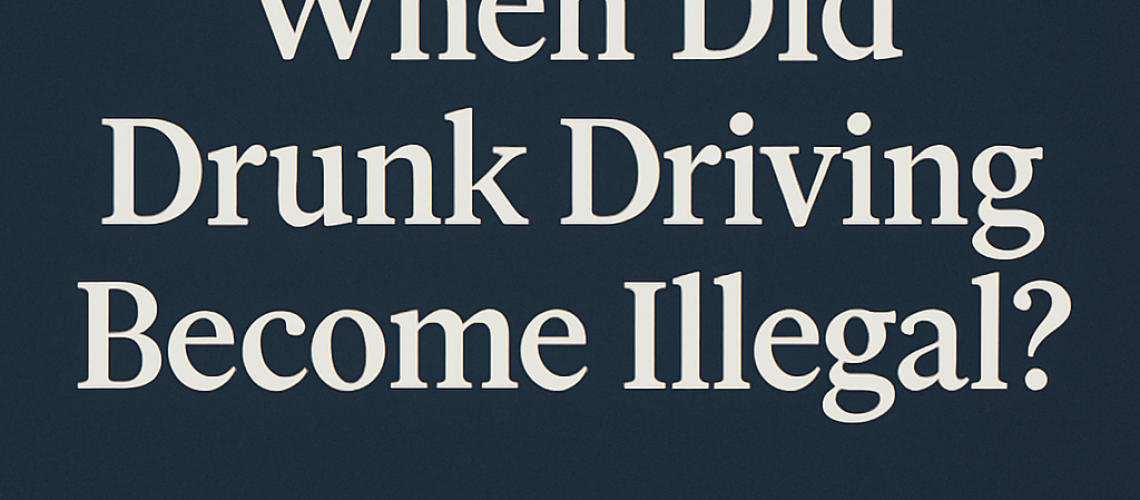Drunk driving has a long and complicated history in the United States. Before modern drunk driving laws and formal dui laws in America existed, driving in the United States was expanding quickly, yet alcohol use behind the wheel was still common. Many states did not have clear rules, and drinking and driving became illegal only after decades of public pressure, activism, and advancements in road safety. Understanding the history of dui laws helps show how impaired driving evolved from an overlooked issue to a nationwide priority designed to protect lives across the United States.
Before diving deeper, new drivers looking to improve safety skills can explore training resources such as what is drivers ed and driving tips for beginners, especially since road safety and reducing drunk driving go hand in hand.
Early History Driving Before DUI Laws
In the early 1900s, there were no clear DUI laws regulating drunk driving in many states. During this time, the automobile was still new, and state laws had not yet adapted to modern risks. Driving while intoxicated happened often because it was still legal in many states, and enforcement tools did not exist.
Erratic driving, intoxication, and impairment caused by drunk individuals on the road were recognized as dangers, but there were almost no laws against drunk driving to prevent it. The history of drunk driving laws shows that drinking and driving became illegal only when lawmakers saw the rising dangers of drunk driving crashes and alcohol related deaths.
First U.S. DUI Law 1906 New Jersey
The first DUI law emerged in 1906 when New Jersey became the first state to make drunk driving illegal. This early law against drinking and driving relied on officer observations because blood alcohol testing had not been invented. A drunk driver could be charged with driving simply for showing signs of impairment.
These early laws were vague and difficult to enforce. Without a legal limit, no standardized blood alcohol concentration measurement, and very limited technology, officers had little more than judgment and observation. Despite these challenges, New Jersey’s law marked the moment when driving become illegal for intoxicated individuals, establishing the first DUI in recorded law.
New York became the first state to adopt similar rules shortly after, showing how laws have evolved state by state.
The Beginning of BAC Standards
By 1939, Indiana set the first legal BAC limit at 0.15 percent. This was a groundbreaking moment in the history of DUI laws because it introduced an objective measure of intoxication. Blood alcohol concentration finally gave officers clear criteria, even though enforcement was still inconsistent.
Over time, many states implemented their own BAC limits, but these early laws lacked uniformity. The legal BAC limit varied widely, making driving while impaired difficult to prosecute in some regions. Technology was also limited, and the first accurate Breathalyzer was not introduced until 1954.
The legal limit continued to evolve, offering more reliable standards that helped shape modern drunk driving laws and penalties for drunk driving that would emerge later.
The Role of MADD and the 1980s Reform
The turning point came in 1980 when Mothers Against Drunk Driving, also known as MADD, entered the national spotlight. MADD was founded by Candy Lightner after her daughter was killed by a drunk driver. Lightner founded Mothers Against Drunk Driving to combat drunk driving and push for stricter laws.
Groups like Mothers Against Drunk Driving fueled a movement that forced lawmakers to pay attention. The emotional impact of victims, the rise in drunk driving deaths, and the consequences of drunk driving became impossible to ignore.
Grassroots activism paired with national safety research and American Medical recommendations began shaping modern policies. During the 1980s, there was a significant push for stricter laws, especially surrounding teen drivers, the drinking age, and prevention programs.
The National Minimum Drinking Age Act of 1984 required all states to set 21 as the minimum drinking age to reduce underage drinking and alcohol related fatalities.
National 0.08 Percent BAC Standard Becomes Law
In 2000, Congress pushed for a uniform legal limit across the nation. To encourage compliance, federal highway funding was linked to states adopting a BAC limit of 0.08 percent. This moment transformed the evolution of DUI laws and strengthened laws against drinking and driving nationwide.
By 2005, all 50 states had adopted the limit of 0.08 as their legal standard. This ensured drunk driving became illegal with a clear threshold for intoxication. The BAC limit of 0.08 is now the legal BAC limit recognized across the nation, and it is illegal to drive above that level.
States have implemented implied consent law policies, meaning drivers agree to blood alcohol testing when they get behind the wheel. These policies support enforcement, reduce impaired driving, and have contributed to a significant decrease in drunk driving fatalities.
DUI Law Timeline in the U.S.
- 1906 New Jersey passes first DUI law
- 1939 Indiana sets first BAC limit at 0.15 percent
- 1954 First Breathalyzer introduced
- 1980 MADD founded to combat drunk driving
- 1984 National Minimum Drinking Age Act requires 21 as legal drinking age
- 2000 Congress pressures states to adopt 0.08 BAC limit
- 2005, All 50 states adopt the national limit
This timeline highlights how the history of DUI laws progressed from early laws focused on behavior to modern laws supported by technology, scientific blood alcohol data, and stricter laws.
Why DUI Laws Got Stricter?
In the 1970s and 1980s, drunk driving accidents surged. Many deaths were caused by drunk drivers, including teens, repeat offenders, and underage drinking incidents. This growing crisis created urgency.
Groups like mothers against drunk driving, national safety experts, and American Medical communities emphasized the dangers of drunk driving and the need to combat drinking and driving through legal reform.
States have implemented stronger penalties for drunk driving, including felony charges for severe cases, jail time for repeat DUI, and DUI conviction consequences that include loss of driving privileges. These penalties were designed to discourage driving while intoxicated and reduce deaths caused by drunk driving.
As drunk driving laws became stricter, driving while impaired became increasingly risky, both legally and socially. Laws against driving intoxicated reflect a system intended to protect communities and save lives.
When Was Drunk Driving First Outlawed in the U.S.?
Drunk driving began to be regulated in 1906 when New Jersey passed the first DUI law. This was the first state to take action against impaired driving even though enforcement standards were minimal.
What Was the Original Legal BAC Limit?
The original legal BAC limit was created in 1939 when Indiana set the first BAC threshold at 0.15 percent. This introduced measurable intoxication and a scientific approach to enforcement.
When Did the 0.08 Percent BAC Limit Become Standard Nationwide?
The BAC limit of 0.08 became a national standard in 2000, and by 2005 it became illegal in all 50 states to drive above that level.
Improving Road Safety Today
Modern drunk driving laws continue to evolve. Training programs, education, and driving safety classes help reduce drunk driving accidents and driving crashes. New drivers can strengthen safety knowledge through resources such as:
how long is defensive driving course
what is defensive driving
how much is driving school
how often can you take defensive driving
For broader support and professional guidance, visit Alliance Driving School in San Diego.





